Chinese Arts from Han to Song Dynasty
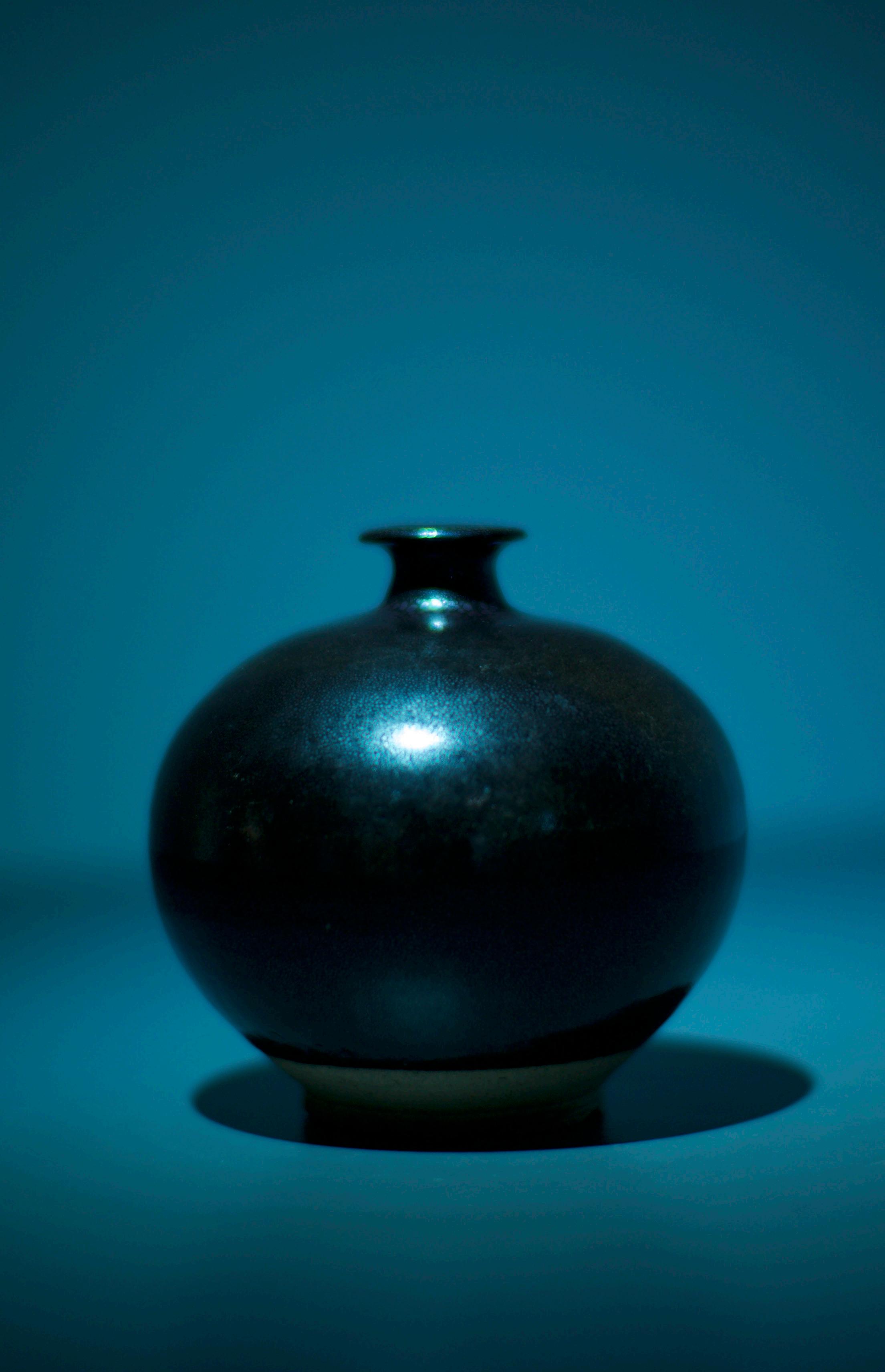
28th AUG - 19th SEP 2025


28th AUG - 19th SEP 2025
Founded in 1988 by the esteemed connoisseur known affectionately as “Mama Lin,” Lam’s Gallery has built a renowned reputation in the international Chinese art market. Over the course of more than three decades, the gallery has earned the trust of collectors, scholars, and institutions worldwide through its unwavering commitment to authenticity, scholarship, and curatorial excellence.
Since the 1990s, the gallery has been led by the second-generation owner, Ms. Midco Lam (林雲翔), whose expertise spans over 30 years in the field. With an extensive understanding of Chinese cultural heritage dating back more than 5,000 years, she has handled an extraordinary array of materials, including ceramics, bronzes, archaic jades, calligraphy, and classical painting. Ms. Lam’s work is widely respected by leading museums, renowned auction houses, esteemed dealers, and discerning private collectors.
Located in M Place, Wong Chuk Hang, Hong Kong, the gallery regularly stages exhibitions that reflect its commitment to quality and historical depth. In addition to her role at Lam’s Gallery, Ms. Lam is also the founder of Songyin Hall (松隱閣), a private collection brand. Highlights from the Songyin Hall collection have been exhibited at the University Museum and Art Gallery (UMAG) of the University of Hong Kong, where Ms. Midco Lam has also generously contributed works from her collection in support of public scholarship and education.

22/f, M Place
54 Wong Chuk Hang Rd, Southern District, Hong Kong
Email: midcolam.art@gmail.com
Instagram: Lamsgallery_Online
WeChat: Midcolam1177
Website: http://www.lams-gallery.com

「松心閣」Lam’s Gallery 成立於1988年,由備受行業 尊敬的鑑賞家“林媽媽”創辦,已在國際中國藝術市場中 建立了卓越的聲譽。在超過三十年的發展過程中,該畫 廊以對真品的堅持、學術研究的深度及策展的卓越表 現,贏得了收藏家、學者和機構的持久信任。
林雲翔女士(Midco Lam)於1990年代踏足古代藝術行 業,至今已有超過30年的專業經歷,涉及門類包括陶瓷、 青銅器、古代玉器、書法及古代繪畫。畫廊的專業成就已 得到世界著名博物館、領先拍賣行、尊貴經銷商以私人 收藏家的認可與尊重。
「松心閣 by Midco」之外,林雲翔女士還創辦了其私人 收藏品牌——松隱閣(Songyin Hall)。松隱閣部分藏品 亦經林女士捐贈,入藏香港大學的藝術博物館(UMAG) ,以支持公共學術及教育事業。

方丈山,又稱為方丈、方壺、方丈洲等,是中国神話傳說中渤海的三神山之一,其餘兩 座則為蓬萊、瀛洲,為仙人所居,在《山海經》中都有記載。
《列子·湯問》中則記載「渤海之東有五山焉,一曰岱輿,二曰員嶠,三曰方壺,四曰瀛洲, 五曰蓬萊」,是為渤海東五山之一。《史記》中的《封禪書》和《秦始皇本紀》也都分別記 載秦始皇、漢武帝也曾使人到方丈求訪仙藥。
漢朝東方朔所著《海內十洲記》中的記載更為詳細:方丈洲在東海中心,是一個四岸各 長五千里的正方島,上空有龍在聚集,有金碧輝煌的宮殿,有耕種芝草的田和玉石泉; 當中還說不欲升天的仙人會到方丈洲居住,所以仙家達数十萬,而宮殿的主人為九源 丈人,他是天下水神和各種水獸的首領。
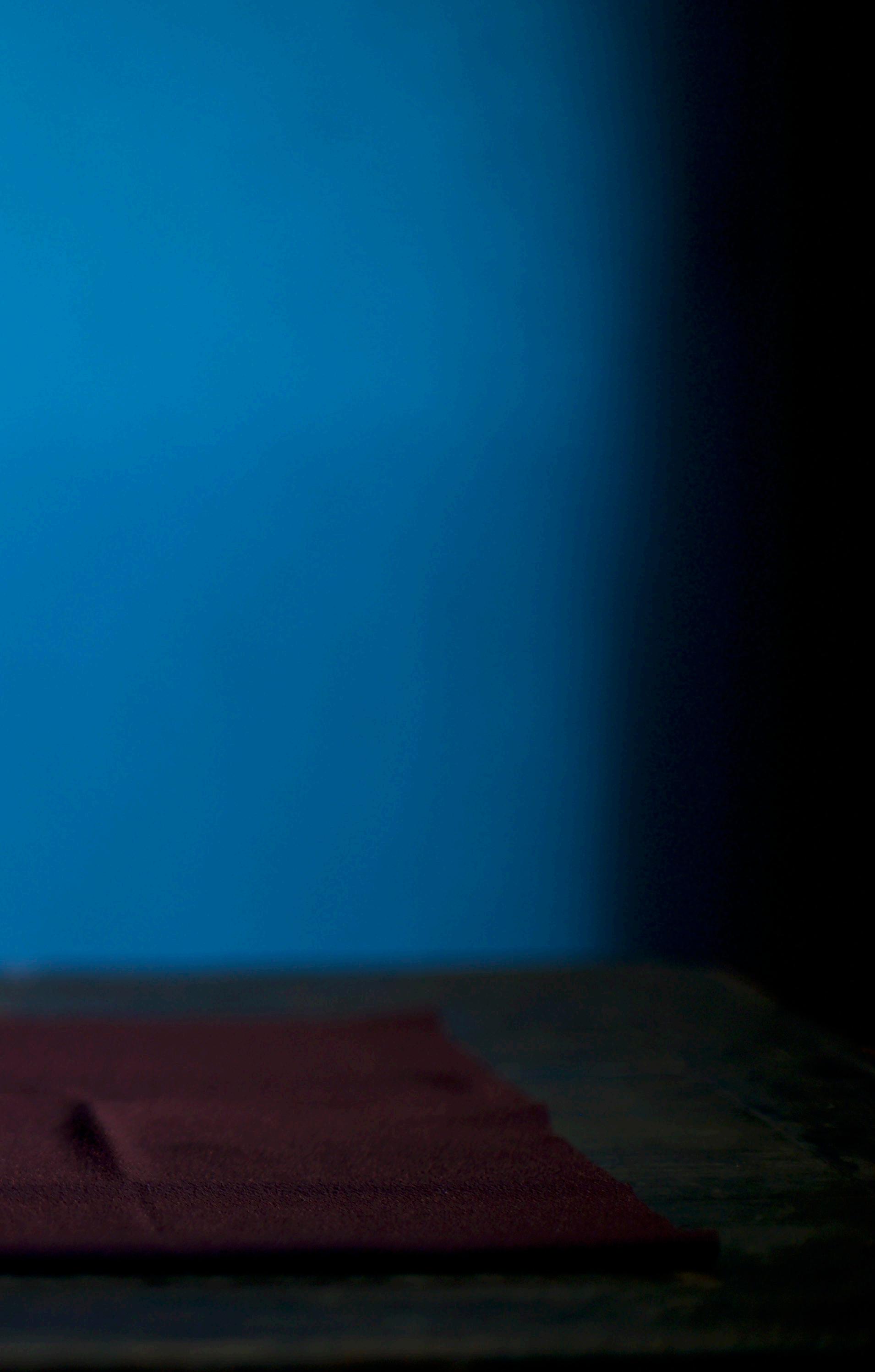
Fangzhang Mountain (方丈山), also known simply as Fangzhang, Fanghu, or Fangzhang Isle, is one of the three sacred mountains of Chinese mythology said to rise from the Bohai Sea, the other two being Penglai and Yingzhou. These were regarded as the abodes of immortals, and all are recorded in the Classic of Mountains and Seas (Shanhaijing).
The Liezi (“Tangwen” chapter) further expands this tradition, noting: “To the east of the Bohai lie five mountains: the first is Daiyu, the second Yuanqiao, the third Fanghu, the fourth Yingzhou, and the fifth Penglai”—thus ranking Fangzhang as one of the Five Isles in the Eastern Sea. Both the Book of the Feng and Shan Sacrifices (Shiji: Fengshan shu) and the Annals of the First Emperor of Qin (Shiji: Qin Shihuang benji) recount that Qin Shihuang and Emperor Wu of Han dispatched envoys to Fangzhang in quest of the elixir of immortality.
The Records of the Ten Isles within the Seas (Hainei shizhou ji), attributed to the Han courtier Dongfang Shuo, gives a more elaborate description: Fangzhang Isle is situated at the very center of the Eastern Sea. It is a perfectly square landmass, each side stretching five thousand li. Dragons gather in the skies above, while palatial halls of resplendent gold and jade rise across the terrain. The island has fields where numinous fungus is cultivated and springs that flow with jade-like waters. Immortals who do not wish to ascend to Heaven take up residence there, so that their numbers reach into the tens of thousands. Presiding over these celestial dwellings is the Elder of the Nine Sources (Jiuyuan Zhangren), revered as the sovereign of all the world’s water deities and the lord of myriad aquatic creatures.
Provenance
Songyin Hall Collection, Hong Kong
陶貼金彩繪皇家舞馬一對 漢代(公元前202年 - 公元220年)
來源:
松隱閣,香港



TWO PAINTED EARTHENWARE CAPARISONED HORSES
NORTHERN QI DYNASTY (A.D 550 - 577)
Provenance
John Berwald, UK
Songyin Hall Collection, Hong Kong
Elegantly modelled in mid-stride, these lively horses with their curving necks and slender legs, are remarkable for the lavish trappings around the head, chest and rump, all highlighted in rich pigments and gilding.
陶貼金彩繪皇家舞馬一對 北齊(公元550年 - 577年)
來源:
John Berwald東方藝術,倫敦 松隱閣,香港
這組姿態優雅、仿佛行進中的駿馬,修長的四肢與弓形的頸項勾勒出 生動神采,尤以頭部、胸前與臀後所飾的繁麗裝具最為矚目,並以濃豔 彩繪與鎏金加以點綴,顯得瑰麗非凡。
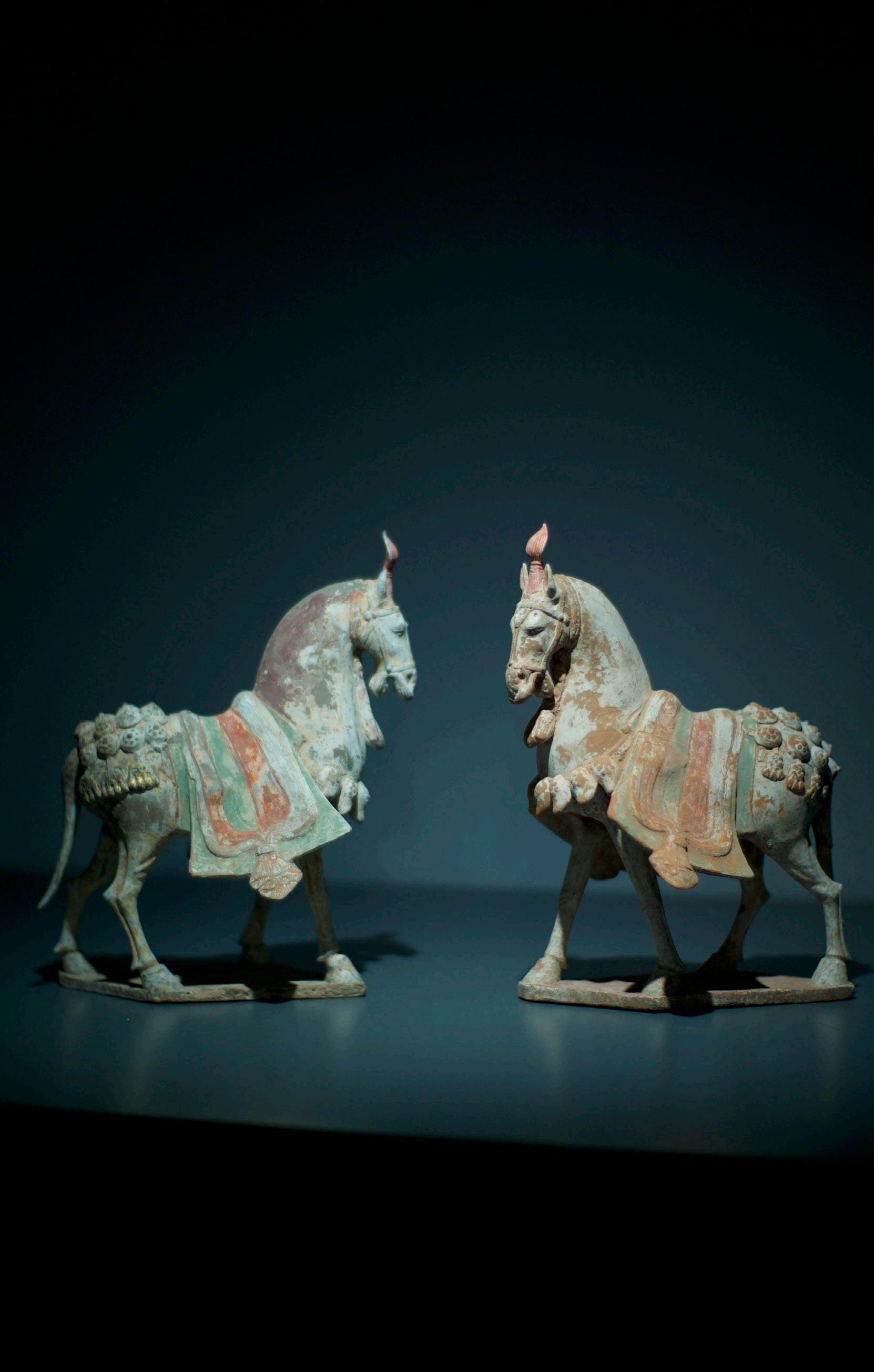


A GREEN GLAZED LONG-NECK KUNDIKA VASE
SOUTHERN DYNASTIES (A.D 420 - 589)
Provenance
Japanese Private Collection, before 2000
Songyin Hall Collection, Hong Kong
白釉長頸淨瓶
南朝(公元420年 — 589年)
來源:
日本私人收藏,2000年以前
松隱閣,香港

Provenance
Priestly and Ferraro, London UK
Songyin Hall Collection, Hong Kong
Literature
Chinese and Korean Ceramics and Works of Arts, Priestley and Ferraro, London UK
A straw-coloured glaze is applied overall, with considerable traces of black pigment on the bridle and straps, and traces of red and tiger-skin like decoration to the saddle.
加彩黃釉陶鞍馬
隋代(公元581年 — 618年)
來源:
覺是軒,倫敦,2020年
松隱閣,香港
出版:
《中國與韓國陶瓷》,2020年,覺是軒,倫敦
這匹馬立於長方形座上,造型精緻,四蹄平穩。頭部繫有轡勒,雙目修 長,眼簾低垂,鼻翼張開,雙耳向後豎起,呈現專注的神態。弓形的頸項 下垂,喉下繫有穗飾或鈴鐺。前額短鬃向前梳理,連接至剃短的鬃毛。
馬背上置有華麗的鞍具,其橋狀的鞍鵠從座面開口中突起,用以防止 滑動,鞍旁垂有長而外張的護板,上掛鐙具。前有飾以流蘇的胸帶固 定,後有繫於壓扁長尾下的鞦帶,並懸掛杏葉狀的墜飾。鞍後另附有 一條帶眼孔的皮帶。
通體施以淡稻草色釉,轡勒與鞍帶上殘留有明顯的黑色彩繪痕跡,鞍 具亦可見紅彩與類似虎斑的裝飾。


Horses which are both glazed and painted are rare and appear to have died out when the sancai glaze technique was invented towards the end of the 7th century.
For a discussion of this, see Imperial China. The Art of the Horse in Chinese History, no. 123, p. 140, where an equestrienne glazed and painted like the present horse is illustrated that was excavated in 1971 from the tomb of Zheng Rentai in Liquan County, Shaanxi, datable to 664 AD. For another equestrienne, with comparable horse, excavated from the same tomb, see The Cream of Xianyang Relics, p. 95.
同時兼具施釉與彩繪的馬俑相當稀少,自七世紀晚期三彩釉 技術出現後,這類工藝幾乎消失。
相關討論可見《Imperial China: The Art of the Horse in Chinese History》,編號123,第140頁,書中所載一件與本 例相類的女騎馬俑,即1971年出土於陝西禮泉縣鄭仁泰墓, 年代可確定為664年。另見《咸陽文物精粹》頁95,亦錄一件 出自同墓的女騎馬俑,其所騎之馬與本器相近。
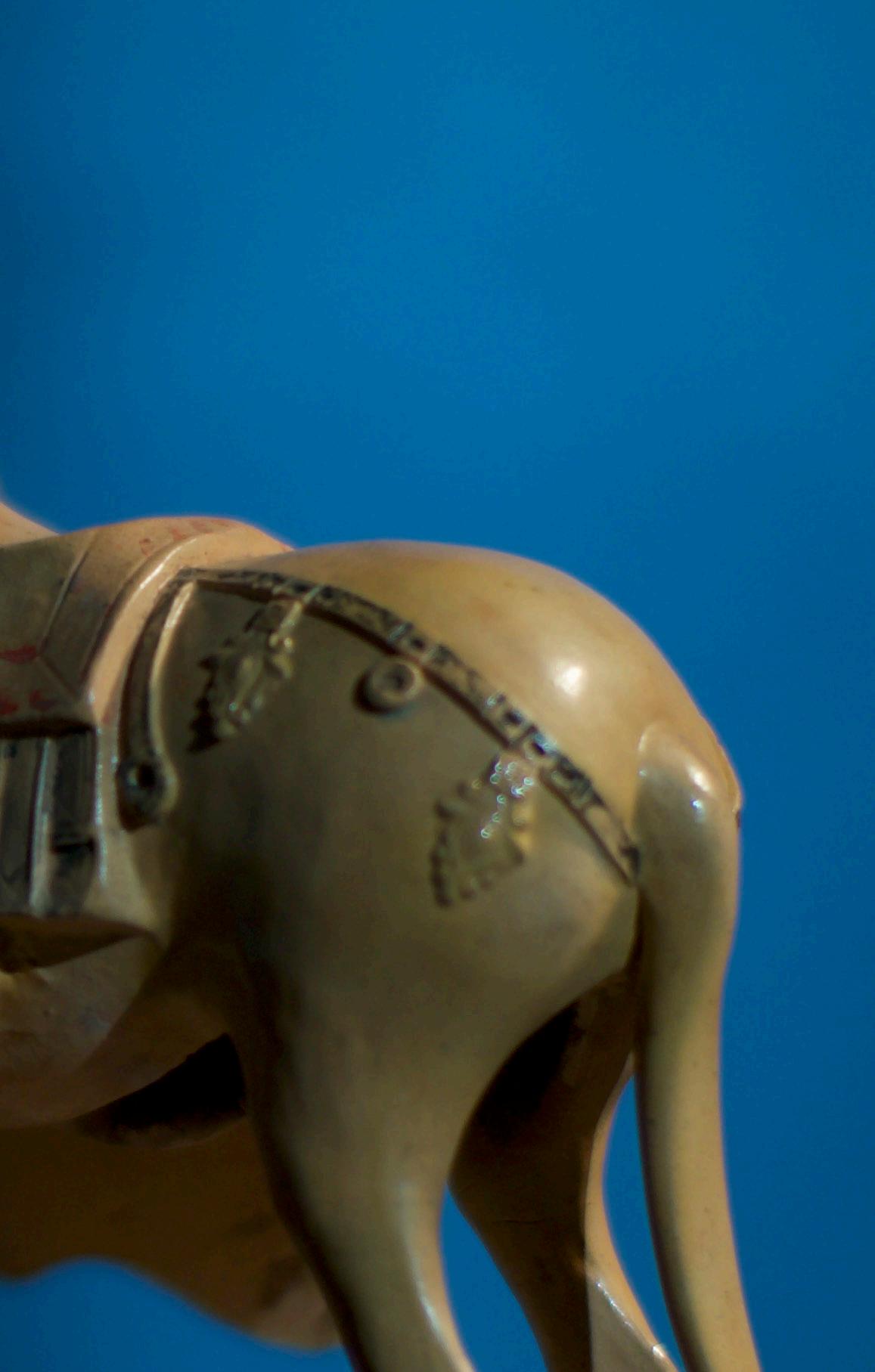


Provenance
Japanese Private Collection, before 1994
Songyin Hall Collection, Hong Kong
白釉長頸淨瓶
隋代(公元581年 — 618年)
來源:
日本私人收藏,1994年以前
松隱閣,香港



PAINTED POTTERY FIGURE OF A PRANCING HORSE
Christian Deydeir, Paris
Songyin Hall Collection, Hong Kong
The dance horse of the Tang Court stands on a rectangular base the right front leg held high in prancing fashion, the back legs bent and overhanging the base creating a dynamic composition, the horse’s head held high and tucked into the body with open mouth.
The mane hangs down to the left side in long strands and the tail is tied by a knot, the terracotta surface covered in a white slip pigment, with areas of red pigment and gold decoration.
藍釉三彩仕女俑
唐代(公元618年 — 907年)
來源:
戴克成,巴黎
松隱閣,香港
唐代宮廷舞馬,立於長方形座上,右前腿高高抬起作騰躍狀,後腿曲折 並懸於座緣之外,構成一種極具動感的姿態。
馬首昂起內收,口微張;鬃毛披垂於左側成束,尾部則以結繩紮束。通 體陶胎覆以白色化妝土,並施以紅彩與鎏金裝飾,華麗而生動。




Several similarly modelled Tang sancai-glazed figures of court ladies are known in museum collections, but examples decorated with blue glaze, which was the most highly prized glaze color in the Tang period, are rare. A similar Tang dynasty tomb figure of a courtesan from the Arthur M. Sackler Collections was included in The Arts of Ancient China exhibition at the Metropolitan Museum of Art, New York, and illustrated in the Metropolitan Museum of Art Bulletin, No. 2, 1973/1974, fig. 66.
Compare also the similar Tang dynasty pottery figure of a courtesan shown standing in the same pose with hands clasped beneath her long shawl, her hair swept up onto a wing-shaped coif, in the Musée Guimet, from the Collection of Michel Calmann, illustrated by Desroches in Chine: des chevaux et des hommes, Paris, 1995, pp. 158-159, no. 61.
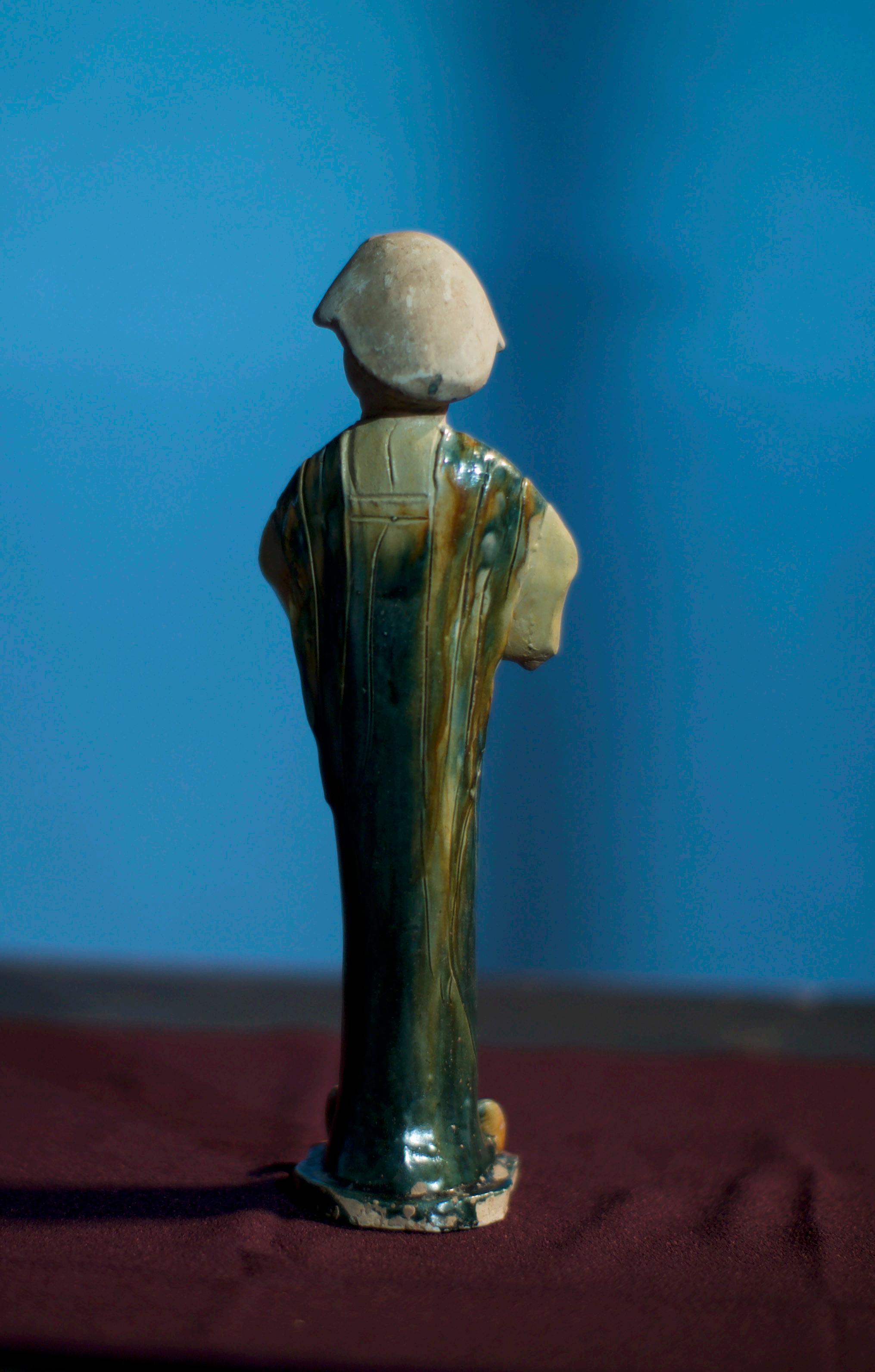
shown standing with her hands clasped beneath the pleated folds of her dappled chestnut- and blue-glazed shawl draped over her shoulders and hanging down the front of her long robes covered with blue glazes covered naturally on the front and back and falling in drappry stripes to the base, with the upturned toes of her shoes protruding at the hem of her skirt, her softly rounded face with delicately modelled features accentuated with red and black pigment over white slip on the unglazed clay, her hair drawn up and gathered in an elaborate double topknot, showing remains of original black pigment.
Provenance
Songyin Hall Collection, Hong Kong
藍釉三彩仕女俑
唐代(公元618年 — 907年)
來源: 松隱閣,香港
有數件造型相近的唐代三彩加彩仕女俑見於博物館收藏,但其中以 藍釉裝飾者極為罕見,藍色在唐代被視為最為珍貴的釉色。紐約大都 會藝術博物館於1973/1974年第二期《館刊》中曾刊載一件來自亞瑟 ·M·賽克勒舊藏的唐代仕女俑(圖66),該俑亦曾參展於該館舉辦的《 中國古代藝術》展覽。
另可比較巴黎吉美博物館所藏一件唐代仕女俑,與本器同樣作雙手抱 於長披帛之下的立姿,髮髻梳成雙翼形高髻。此件原為米歇爾·卡爾曼 舊藏,曾著錄於德羅什《中國:馬與人》(巴黎,1995年),頁158-159, 編號61。



Provenance
Songyin Hall Collection, Hong Kong
彩繪仕女俑
唐代(公元618年 — 907年)
來源:
松隱閣,香港

Provenance
Songyin Hall Collection, Hong Kong
彩繪仕女俑
唐代(公元618年 — 907年)
來源:
松隱閣,香港

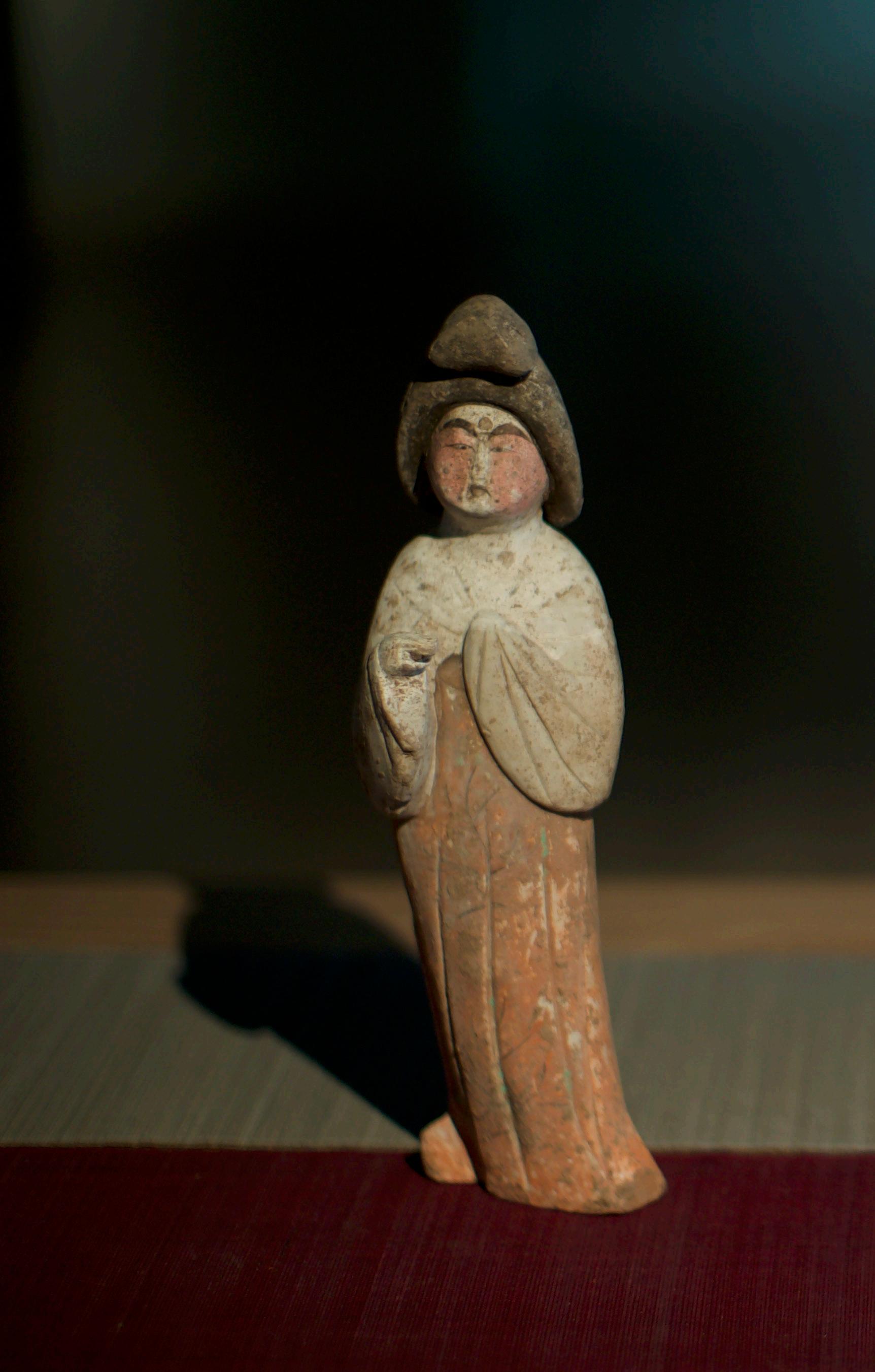
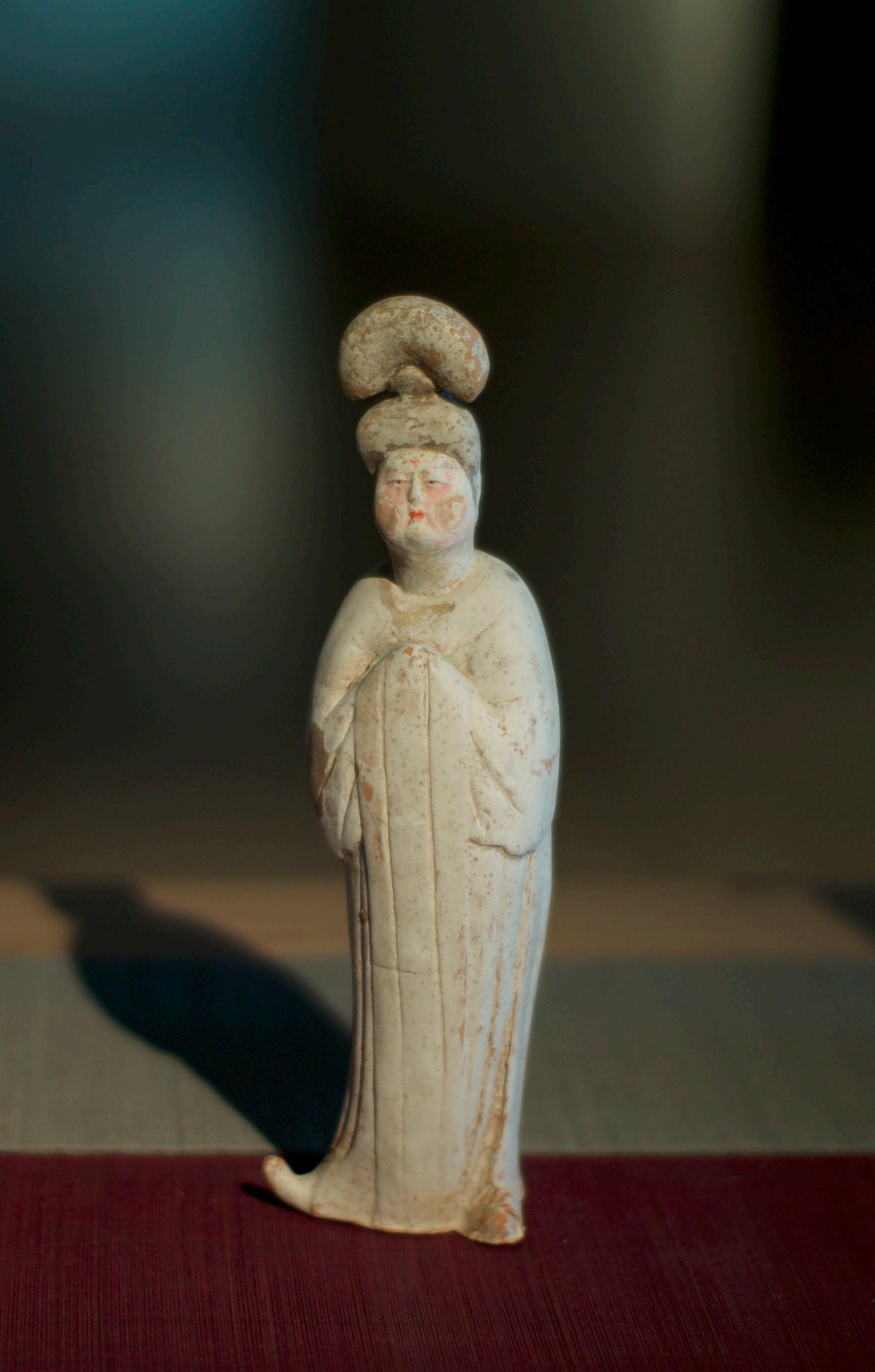
Provenance
Songyin Hall Collection, Hong Kong
彩繪仕女俑
唐代(公元618年 — 907年)
來源:
松隱閣,香港
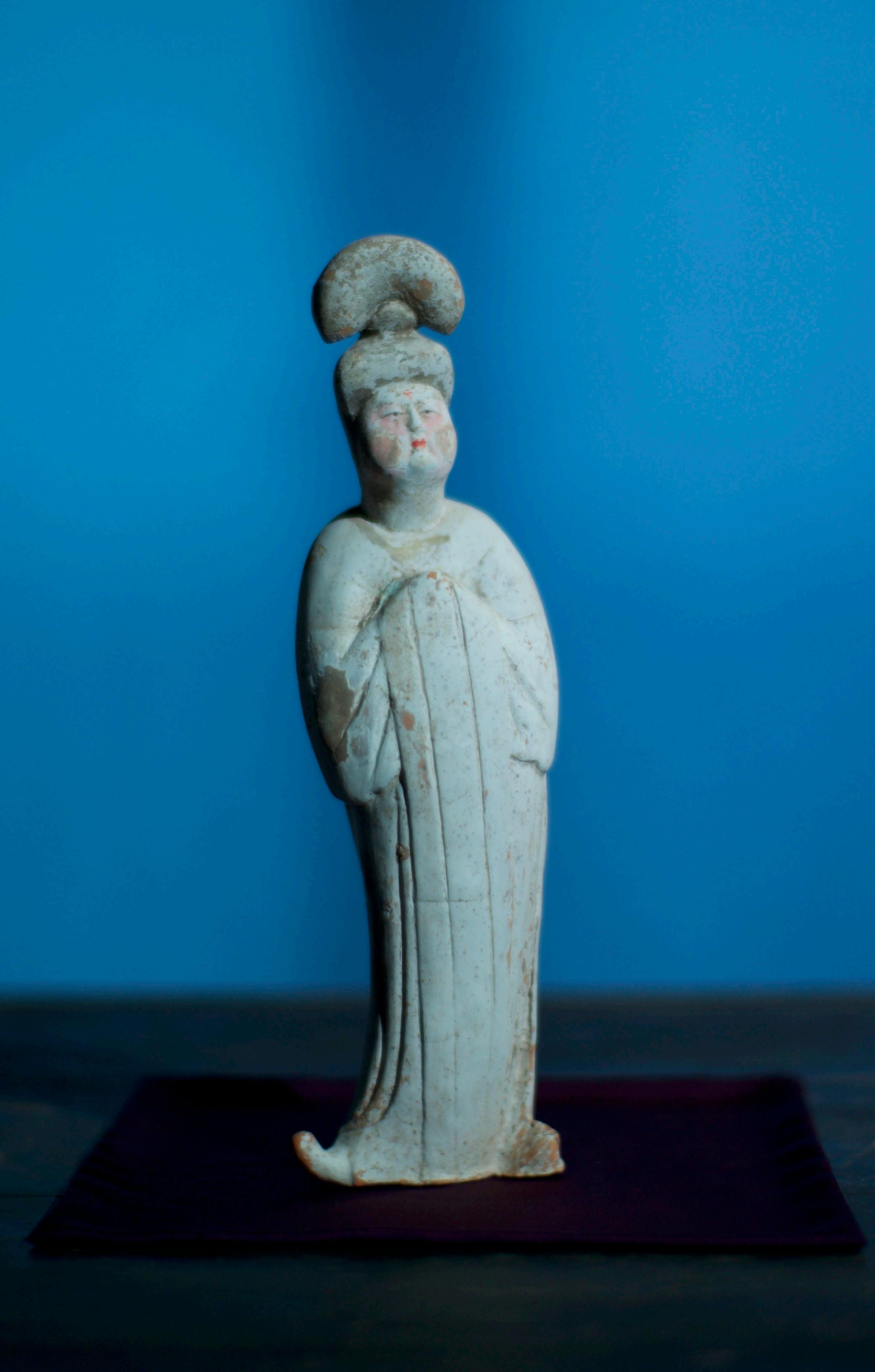
Provenance
Songyin Hall Collection, Hong Kong
白釉花口蓋盒
唐代(公元618年 — 907年)
來源:
松隱閣,香港

A WHITE GLAZED ‘ZEZHOU’ FOLIATE COVER BOX
K.Y. Fine Arts, Hong Kong
Songyin Hall Collection, Hong Kong
澤州窯白釉粉盒
唐代(公元618年 — 907年)
來源:
繼遠美術,香港
松隱閣,香港



A CARVED ‘YAOZHOU’ CELADON-GLAZED ‘PEONY’ DISH
Provenance
Songyin Hall Collection, Hong Kong
Compare a similar dish in the Baur Collection, Geneva, illustrated in John Ayers, Chinese Ceramics in the Baur Collection, vol. I, Geneva, 1999, pl. 25A, and another in the Fitzwilliam Museum, Cambridge, illustrated by G.M. Gompertz, Chinese Celadon Wares, London, 1958, pl. 45A.
耀州窯青釉刻牡丹紋盤 北宋(公元960年 - 1127年)
來源:
松隱閣,香港
可比較日內瓦鮑爾收藏館(Baur Collection, Geneva)所藏一件類 似器,著錄於John Ayers《Chinese Ceramics in the Baur Collection》第一卷(1999年,日內瓦),圖版25A;
另可參考劍橋大學菲茨威廉博物館(Fitzwilliam Museum, Cambridge)所藏相似例,著錄於G. M. Gompertz《Chinese Celadon Wares》(倫敦,1958年),圖版45A。

A JULU TYPE SGRAFFIATO PEONY PILLOW
NORTHERN
(A.D 960 - 1127)
Provenance
Songyin Hall Collection, Hong Kong
鉅鹿型白釉剔牡丹紋枕
北宋(公元960年 - 1127年)
來源:
松隱閣,香港

A JULU WHITE GLAZED TEA BOWL
NORTHERN
(A.D 960 - 1127)
Provenance
Japanese Tea Master Collection, Tokyo
Songyin Hall Collection, Hong Kong
鉅鹿白無地筒茶碗
北宋(公元960年 - 1127年)
來源:
日本茶人收藏,東京
松隱閣,香港



A MINITAURE DANGYANGYU WHITE GLAZE DISCMOUTHED VASE
(A.D 960 - 1127)
Provenance
Eiji Nishigawa, Tokyo
Songyin Hall Collection, Hong Kong
當陽峪跳刀紋白釉袖珍盤口瓶
北宋(公元960年 - 1127年)
來源:
西川美術店,東京
松隱閣,香港

(A.D 960 - 1127)
Provenance
Eiji Nishigawa, Tokyo
Songyin Hall Collection, Hong Kong
當陽峪黑白釉袖珍直頸瓶
北宋(公元960年 - 1127年)
來源:
西川美術店,東京
松隱閣,香港



A LONGQUAN CELADON TEA BOWL
SOUTHERN SONG DYNASTY (A.D 1127 - 1279)
Provenance
J.J.Lally & Co., New York
Songyin Hall Collection, Hong Kong
Literature
SONG DYNASTY CERAMICS: The Ronald W. Longsdorf Collection, March 15 - April 13, 2013, J.J.Lally & Co., New York.
龍泉青瓷束口碗
南宋(公元1127年 - 1279年)
來源:
藍理捷,紐約
松隱閣,香港
出版:
《宋磁:羅納德·隆斯多夫收藏》,2013年3月15 - 4月13日,藍理捷,紐 約



Among the various types of Henan oil-spot ware, the most common is the Tenmoku tea bowl. Four particularly renowned examples are preserved in Japan, respectively in the Tokugawa Art Museum, the Fujita Art Museum, the Kyoto National Museum, and the Ryūkōin sub-temple of Daitokuji.
The Henan oil-spot Tenmoku in the Ryūkōin is designated an Important Cultural Property and was formerly in the collections of Tsuda Sōeki (Sen no Rikyū) and Kōgetsu Sōgan. The example in the Tokugawa Art Museum, once owned by Tokugawa Ieyasu, is recognized as a meibutsu (“Great Noted Object”).
In contrast to the tea bowls, the present Henan oil-spot tulu-shaped vase is of extreme rarity. With its full, rounded form, the silver-sheened oil-spot markings evenly distributed across the surface, it may well represent a unique surviving example.
Provenance
Songyin Hall Collection, Hong Kong
河南油滴吐魯瓶
宋代(公元960年 - 1279年)
來源:
松隱閣,香港
河南油滴常見的品種是天目茶碗,日本有四件著名的傳世河南油滴天 目茶碗,分別藏於德川美術館、藤田美術館、京都國立博物館和大德寺 龍光院。
其中大德寺龍光院的河南油滴天目茶碗被認定為重要文化財,為津田 宗及、江月宗玩藏品。德川美術館的河南油滴天目為德川家康藏品,被 認定為「大名物」。
本件河南油滴的吐魯瓶存世罕見,其造型飽滿,油滴髮色銀亮,分佈 均勻,或為孤例。



Provenance
Songyin Hall Collection, Hong Kong
三彩雙魚洗
金代(公元1115年 - 1234年)
來源:
松隱閣,香港
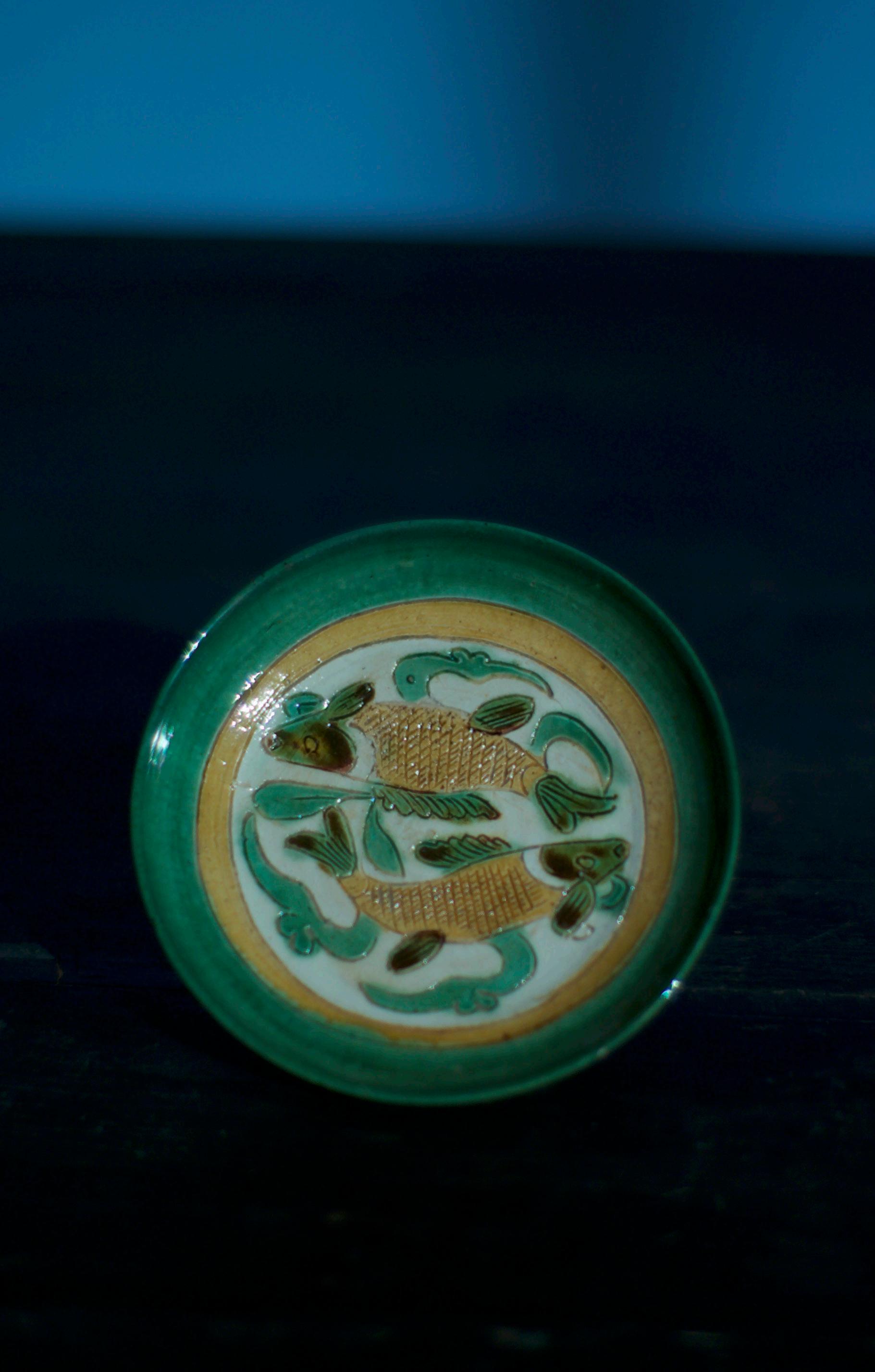


AN UNUSUALLY LARGE AMBER-GLAZED PHOENIX-HEAD
Provenance
Songyin Hall Collection, Hong Kong
of impressively generous proportions, the mouth modelled in the form of a hexalobed cup above a phoenix head and a long ribbed neck, all resting on an elongated ovoid body, covered overall with a lustrous amber-brown lead glaze in two layers.
遼 黃釉鳳首瓶
遼代(公元916年 - 1125年)
來源: 松隱閣,香港
口沿作六瓣花口,覆於鳳首之上,頸部修長並作縱向棱脊,承接於細長 橢圓腹。通體施以雙層琥珀色鉛釉,光澤瑩潤。
參考: 伊勢彥信舊藏,蘇富比2025年9月9日,拍品5134




Email: midcolam.art@gmail.com
Instagram: Lamsgallery_Online WeChat: Midcolam1177
Website: http://www.lams-gallery.com